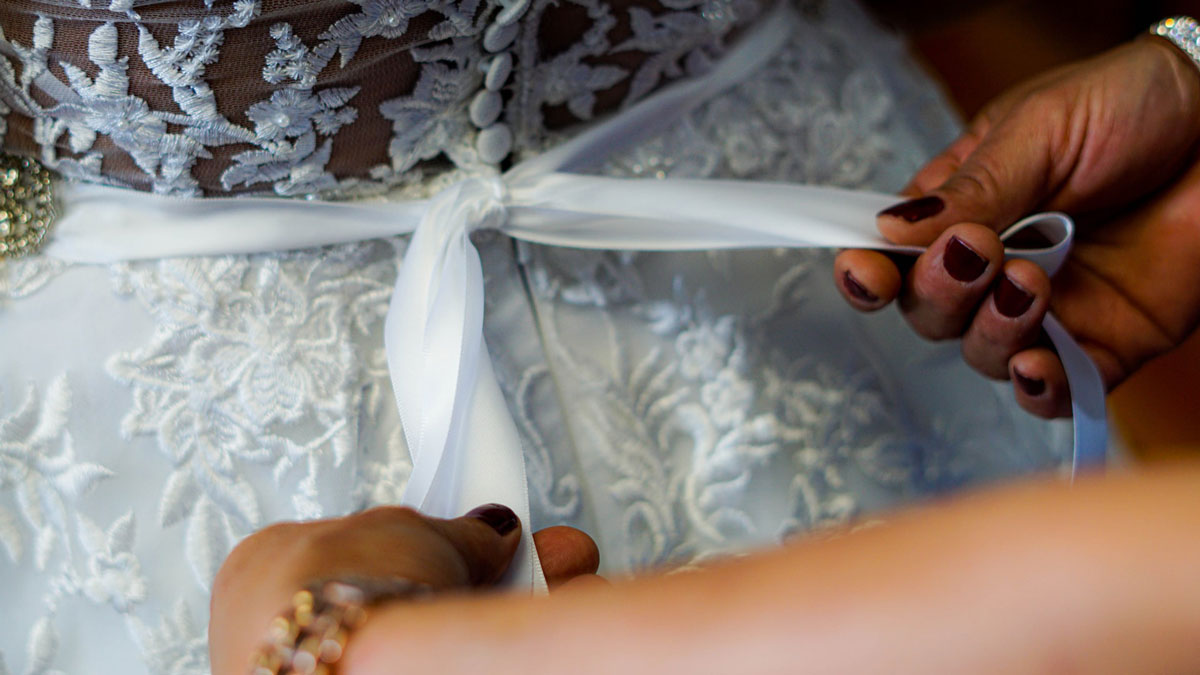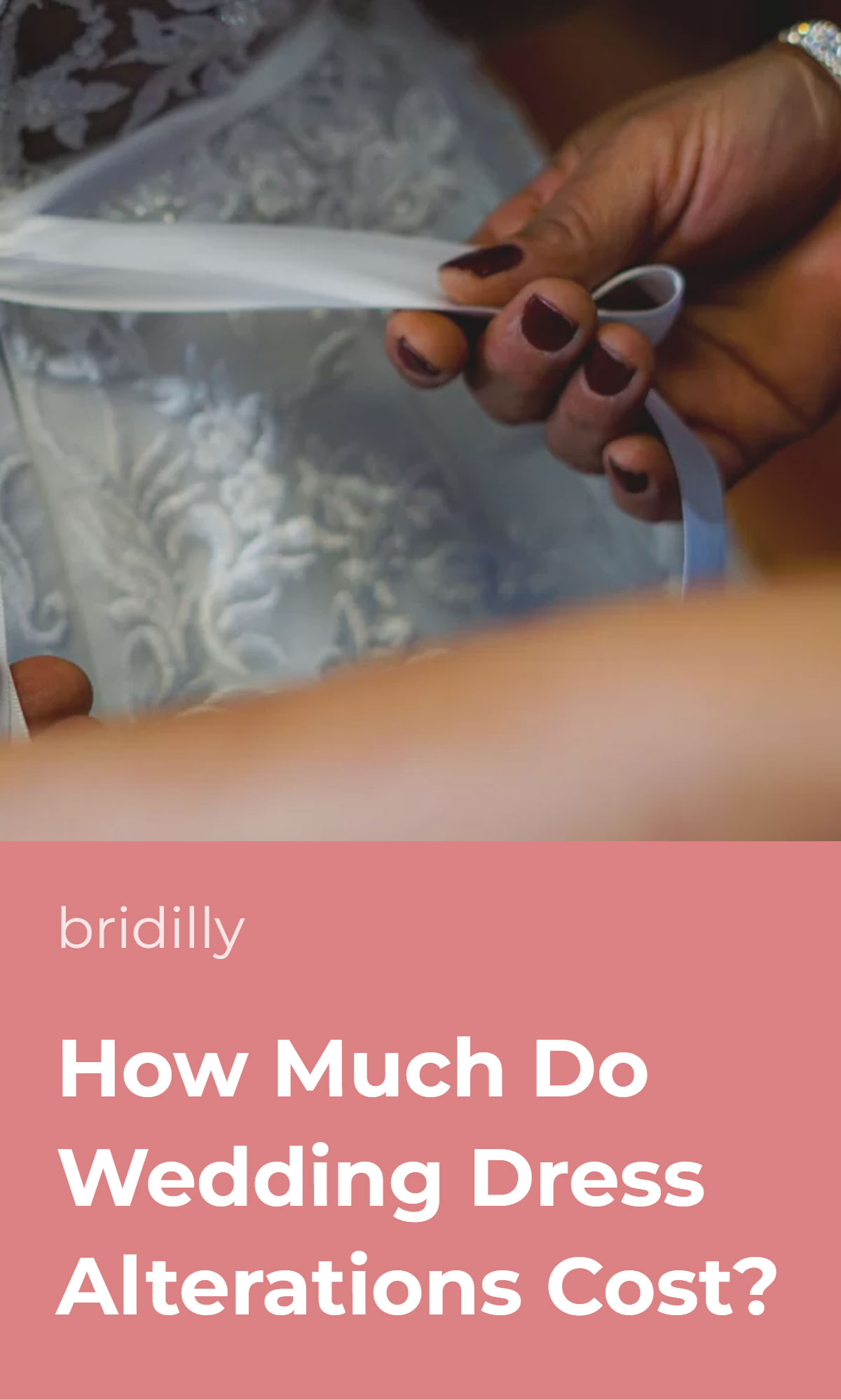When setting the budget for your dream gown, don’t forget to estimate the wedding dress alterations cost.
If you neglect the price of wedding dress fittings before buying your gown, you may be unpleasantly surprised after getting the quote.
Altering a wedding gown always costs more than casual clothing due to the amount and type of fabric and design intricacy.
Furthermore, dresses often undergo multiple rounds of alterations to fit the bride flawlessly. Even with seemingly minor alterations, the costs add up quickly.
However, seeing yourself in the mirror in a perfectly-fitted wedding dress is worth the money. Most importantly, consider the added expenditures in advance.
Table of Contents [show]
Bespoke Customizations
Some wedding dress alterations are basic and required for most brides, such as hemming and fitting the waist.
They are usually relatively affordable and straightforward. Meanwhile, bespoke wedding dress customizations are optional and costly.
The term “bespoke customizations” refers to any custom changes to a wedding gown, such as changing the sleeve style, adding a detachable train, embellishing the bodice, or incorporating a colorful skirt insert.
Bespoke customizations may cost you anywhere from $150 to over $1,000, depending on your request. Adding sleeves to a sleeveless gown costs about $200-$400, while modernizing a vintage wedding dress may cost over $1,500.
Basic Hemming
Hemming is among the easiest wedding dress alterations. You’ve likely shortened a casual skirt at least once and know that it doesn’t take much time or effort. In fact, many brides choose to do it themselves.
However, wedding gown hemming can be more intricate than casual skirt hemming.
Many gowns feature layered skirts and are made from delicate materials that require careful handling. The design intricacy can significantly affect the wedding dress hemming price.
Minimalistic gown hemming costs about $40 on average and takes no longer than a couple of days, depending on the sewer’s workload. But if you have a ball gown from ten layers of organza, expect to pay up to $150.
Most wedding gowns are longer than average floor-length dresses to ensure they fit brides of any height on high heels.
However, if you need to make the skirt longer, note that this type of alteration usually costs more than shortening the hem.
The price depends on the method of making your dress longer. Some gowns have a big hem allowance. In this case, the sewer can let down the hem – that’s the easiest way, and it costs no more than shortening.
Other gowns have little to no hem allowance, and the seamstress must add a separate piece of fabric. This may cost you up to $200.
Sleeve Alterations
Not all sleeve alterations are the same. Shortening the gown sleeves or straps may cost you less than $20 – that’s one of the simplest wedding dress alteration types.
Sometimes, brides need to make the sleeves narrower or wider. In most cases, such alterations cost up to $30 if the sleeve design isn’t overly intricate.
If you’d like to remove sleeves from your gown, expect to pay about $20. You may even do it yourself if you have basic sewing skills – all you need to do is detach the sleeves using a sewing ripper and finish a new hem.
On the other hand, adding sleeves is a complex process that classifies as bespoke customization. Depending on the desired sleeve style, it may cost you multiple hundreds of dollars.
The only exception is spaghetti straps – these can be added to a strapless gown for under $20.
Consider adding detachable spaghetti straps to your strapless dress – this cheap alteration will allow you to dance freely during the reception.
Waist Alterations
Wedding dress waist alterations are necessary for nearly every bride.
Even if the sizing of your gown is correct, chances are, you’ll need to take the waist in or let it out slightly. And if you’re losing weight, the waist alterations may be drastic.
Most wedding gowns have sufficient seam allowance to let the waist out by about a size. In other words, the tailor likely won’t need to add any fabric if you only need to make the waist bigger slightly.
Taking in or letting out the waist costs $35-$60 per side on average. The price can be higher if your dress features intricate embellishments near the seams, as the sewer will have to remove them and sew them back after the job is done.
However, if your dress is too small, the sewer will have to be creative.
For instance, they may add fabric panels on the sides or change the zipper to a corset back. That’s more labor-intensive work with a significantly higher price that may exceed $250.
The same applies to shoulder and hip alterations. Most women don’t have perfectly balanced figures and wear different sizes for the top and the bottom.
For example, if your bust fits a size 12, the waist fits a size 8, and the hips a size 10, you should order size 12 and get the waist and hips altered.
If you only need to take in or let out the seams by a size, expect to pay from $35 to $60 per side for a minimalistic gown and more for dresses with embellishments.
These alterations may not seem expensive, but the costs quickly add up if you need to tweak the gown in every area.
Suppose you need to take in the shoulders and the waist and let out the hips of your mermaid gown by a size. Even at the lowest rate, you would pay about $210 for all the work.
Train Customizations
A long train looks irresistible as you walk down the aisle but transforms into a hazard on the dancefloor.
The solution is simple – adding a train loop. It allows you to attach the train end to your dress back, thus making it shorter.
Some brides choose a wrist train loop that looks like a bracelet. Either way, this minor customization isn’t overly time and labor-consuming and usually costs under $20.
An exception is very long trains that require multiple buttons and loops. The tailor must pay attention to how the train fabric drapes and spend more time sewing, so this may cost you over $60.
Adding a train is classified as bespoke customization. It can cost you over $300 or more if the train is very long, embellished, or has a detachable construction.
Adding Bra Cups
You’ve likely seen wedding gowns with an illusion neckline and open back and wondered how you wear them without a bra. Simple – you can add bra cups to the bodice. It usually costs about $20-$30, with rare exceptions.
For instance, if your dress has a complex corset bodice, very delicate fabric, or heavy embellishments on the bust, the alteration will be more labor-intensive and thus cost more.
Adding Embellishments
The price of wedding gown alterations can usually be estimated based on the job type, but adding beading and other embellishments is an exception. The cost can vary significantly based on the labor complexity and amount.
Some brides only want to add a single jewel to the belt, while others request tailors to embellish the entire train. Therefore, the easiest way to estimate the price is by taking an average hourly rate.
Experienced masters take about $30 an hour for beading work, so you may pay under $15 for minor customizations and over $5,000 for the most intricate projects.
Note that the hourly rate doesn’t include materials, which can also be expensive.
Average Total Wedding Dress Alterations Cost
Estimating the total cost of wedding dress alterations isn’t simple, as each case is different. Some brides may need all the alterations mentioned above, while others suffice with basic hemming.
Data shows that the average total price of wedding dress alterations in the U.S. ranges between $150 and $600.
That’s a fair price for ensuring your gown looks flawlessly on your wedding day, but you should budget for it in advance.
Some bridal salons and independent sewers charge a flat wedding dress fitting rate of $500-$700 on average.
A flat rate may be beneficial if your gown has an intricate design and needs extensive alterations. However, if your dress has a simple cut and requires minimal tweaks, you risk overpaying.
Factors Affecting the Alterations Cost
For the most part, wedding dress alteration cost depends on the job type and dress design. However, these aren’t the only factors affecting the price.
The delicacy of fabric can skyrocket the wedding gown alteration price.
If your dress is made from silk, organza, or chiffon, you will pay more for any alterations than if it was made from polyester. Delicate fabrics require hand stitching versus machine stitching.
Your location matters. Brides in major metro areas always pay more than those living in small towns due to the difference in cost of living.
The average cost of wedding dress alterations differs by state, too. For a comparison, brides in Georgia and Texas pay about $225 for all alterations, while New York and California brides can pay over $500.
Lastly, some seamstresses charge extra fees for rush orders. If you need to skip the queue to get your dress on time, the sewer may accommodate you for an additional cost.


















No Comments Add one
Leave a Comment